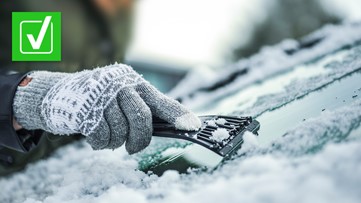During hurricane season, many people track the path of each storm using the National Weather Service’s Doppler radar or other weather radar systems.
After Hurricane Helene made landfall in the Big Bend area of Florida’s northwestern coast on Sept. 26, an X post with over 1 million views claimed a flock of birds could be seen on radar near Tallahassee, Florida.
But some people who commented on the post questioned if birds can actually be detected by radar.
THE QUESTION
Can birds appear on weather radar?
THE SOURCES
- National Weather Service
- FOX Weather
- The Weather Channel
- The Cornell Lab of Ornithology
- National Audubon Society
- Audubon Florida
- Meteorologist Rob Carlmark
- Meteorologist Ben Dery
- Andrew Farnsworth, Ph.D., a bird migration expert at the Cornell Lab of Ornithology
THE ANSWER
Yes, birds can appear on weather radar.
WHAT WE FOUND
While we were unable to VERIFY whether the viral radar image posted on X actually shows birds, all of our sources agree that weather radar can detect migratory birds and other animals, including those trapped in a hurricane.
“Radar actually picks up on lots of things in the atmosphere, like bugs, sharp temperature changes, density changes and even birds,” Ben Dery, a meteorologist at VERIFY partner station KARE, said in 2018.
Rob Carlmark, a meteorologist at VERIFY partner station KXTV, agrees.
“Birds can show up on radar. In fact, when birds roost at night then fly out in the morning, it’s common to see them show up,” Carlmark told VERIFY.
In the summer and fall before annual migrations begin, many bird species are known to gather at large communal roosting sites, according to the National Weather Service. These birds are often detected by NWS Doppler radar imagery in unique doughnut patterns that are known as “roost rings.”
“Roost rings” occur when the radar beam detects thousands of birds taking off from their roosting sites around dawn to forage for insects, NWS says. Due to the atmosphere’s composition in the morning, radar beams often have a downward tilt which results in more significant signals of birds than during the warmer evenings, according to FOX Weather.
“As they travel further from their roosting site and reach higher altitudes, they are detected by radar until they either rise above or drop below the radar beam,” the NWS office in Green Bay, Wisconsin, says on its website. “Some species typically return to the same roosting sites in the evening, which are usually situated near bodies of water.”
Birds aren’t the only animals that can be detected on radar — bats and ladybugs have also been spotted over the years.
When it comes to hurricanes, some migratory bird species become trapped in the storm while others detour around the storms to avoid them, according to Audubon Florida.
“Radar images often show birds in the eye of hurricanes, unable to escape through the eyewall. And hurricanes are renowned for blowing birds many miles off course, with rare seabirds and Caribbean birds found after landfall in the most unlikely places in our state. Some species will shelter in place, finding places for refuge or holding on to thick branches,” Audubon Florida says.
Andrew Farnsworth, a bird migration expert at the Cornell Lab of Ornithology, told Vox that exhausted birds who are blown further inland during a hurricane can die if they can’t easily find food.
But some bird species use hurricanes to their advantage. Tagged shorebirds, for example, have been documented flying through hurricanes and even using their prevailing tailwinds for a boost, Audubon Florida says. Meanwhile, a recent study found that Desertas petrels, rare seabirds that live on a Portuguese island, actually follow hurricanes for days to search for prey in the Atlantic Ocean, according to a Washington Post report.













